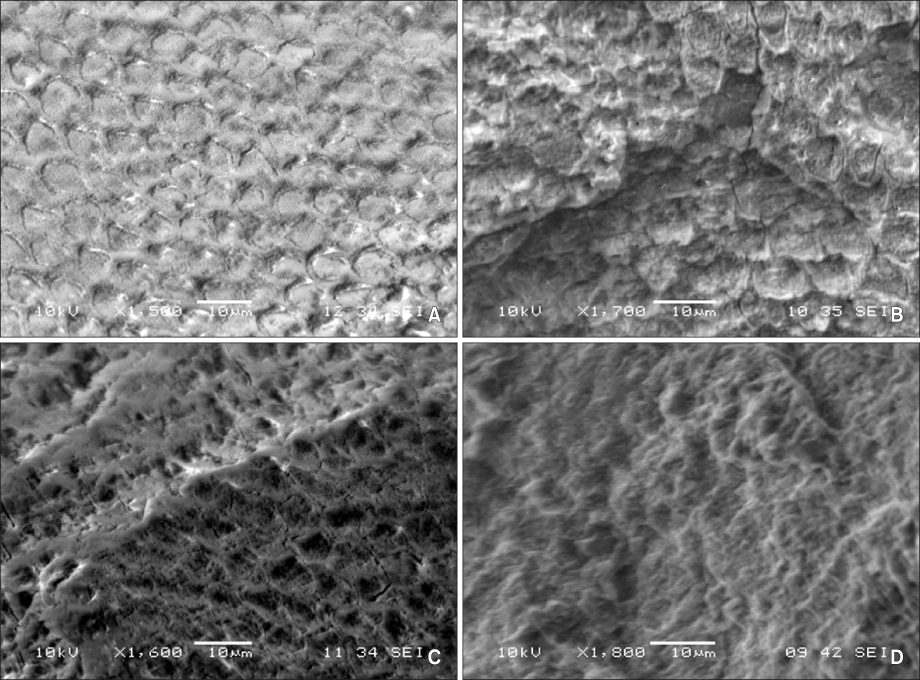Korean J Orthod.
2010 Apr;40(2):87-94. 10.4041/kjod.2010.40.2.87.
Modified laser etching technique of enamel for bracket bonding
- Affiliations
-
- 1Department of Orthodontics, Hallym University Sacred Heart Hospital, Korea. smlee0624@gmail.com
- KMID: 2273216
- DOI: http://doi.org/10.4041/kjod.2010.40.2.87
Abstract
OBJECTIVE
Many studies have carried out research on comparisons between laser etching and conventional etching systems to investigate methods of reinforcing shear bond strength. The purposes of this study were to assess the efficiency of bonding with erbium, chromium doped: yttrium-scandium-gallium-garnet (Er,Cr:YSGG) laser etching combined with the conventional etching technique.
METHODS
Sixty-four sound premolars, extracted for orthodontic purposes, were randomly divided into 4 groups and treated in the following manner. First group, conventional etching of 37% phosphoric acid for 15 seconds (control); second group, 1.5 W laser etching for 10 seconds followed by conventional etching; third group, conventional etching followed by 1.5 W laser etching; fourth group, 1.5 W laser etching for 15 seconds only. We assessed the shear bond strength, the surface characteristics, and the adhesive remnant index scores between all groups.
RESULTS
Experimental groups showed higher shear bond strength than the control group. But no statistically significant differences were found between the second and third groups. Adhesive remnant scores were compared with the Kruskal-Wallis test, and no statistically significant differences were found between all groups.
CONCLUSIONS
To obtain maximum shear bonding strength, a combined technique of Er,Cr:YSGG and 37% phosphoric acid is useful even though it may be inconvenient.
Keyword
MeSH Terms
Figure
Reference
-
1. Stern RH, Sognnaes RF. Laser beam effect on dental hard tissues. J Dent Res. 1964. 43:873.2. Suh CH, Chang NY, Chae JM, Cho JH, Kim SC, Kang KH. Efficiency of ceramic bracket debonding with the Er:YAG laser. Korean J Orthod. 2009. 39:213–224.
Article3. An KM, Sohn DS. The effect of using laser for ceramic bracket bonding of porcelain surfaces. Korean J Orthod. 2008. 38:275–282.
Article4. von Fraunhofer JA, Allen DJ, Orbell GM. Laser etching enamel for direct bonding. Angle Orthod. 1993. 63:73–76.5. Ozer T, Başaran G, Berk N. Laser etching of enamel for orthodontic bonding. Am J Orthod Dentofacial Orthop. 2008. 134:193–197.
Article6. Uşümez S, Orhan M, Uşümez A. Laser etching of enamel for direct bonding with an Er,Cr:YSGG hydrokinetic laser system. Am J Orthod Dentofacial Orthop. 2002. 122:649–656.
Article7. Öztürk F, Babacan H, Nalçacı R, Kuştarc A. Effects of direct and indirect bonding techniques on bond strength and microleakage after thermocycling. Korean J Orthod. 2009. 39:393–401.
Article8. Bishara SE, Trulove TS. Comparisons of different debonding techniques for ceramic brackets: an in-vitro study. Part 1. Background and methods. Am J Orthod Dentofacial Orthop. 1990. 98:145–153.
Article9. Rizoiu I, Kohanghadosh F, Kimmel AI, Eversole LR. Pulpal thermal responses to an erbium, chromium:YSGG pulsed laser hydrokinetic system. Oral Surg Oral Med Oral Pathol Oral Radiol Endod. 1998. 86:220–223.
Article10. Ariyaratnam MT, Wilson MA, Mackie IC, Blinkhorn AS. A comparison of surface roughness and composite/enamel bond strength of human enamel following the application of the Nd:YAG laser and etching with phosphoric acid. Dent Mater. 1997. 13:51–55.
Article11. Reynolds IR. A review of direct orthodontic bonding. Br J Orthod. 1975. 2:171–178.
Article12. Wang X, Ishizaki NT, Suzuki N, Kimura Y, Matsumoto K. Morphological changes of bovine mandibular bone irradiated by Er,Cr;YSGG laser: an in vitro study. J Clin Laser Med Surg. 2002. 20:245–250.
Article13. Kimura Y, Yu DG, Fujita A, Yamashita A, Murakami Y, Matsumoto K. Effects of erbium,chromium:YSGG laser irradiation on canine mandibular bone. J Periodontol. 2001. 72:1178–1182.
Article14. Johnston CD, Hussey DL, Burden DJ. The effect of etch duration on the microstructure of molar enamel: an in vitro study. Am J Orthod Dentofacial Orthop. 1996. 109:531–534.
Article
- Full Text Links
- Actions
-
Cited
- CITED
-
- Close
- Share
- Similar articles
-
- Evaluation of different enamel conditioning techniques for orthodontic bonding
- Orthodontic bonding to acid- or laser-etched prebleached enamel
- The effects of a sealant resin on enamel demineralization in orthodontic bracket bonding
- Orthodontic bracket shear bond strength to ND:YAG laser and ER:YAG laser irradiated enamel
- Effects of the different ceramic bracket bases on shear bond strength




